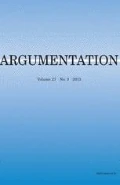Abstract
This paper deals with the explanation the maxim of relevance provides for the way utterances in argumentative discourse follow each other in an orderly and coherent fashion. Several senses are distinguished in which utterances can be considered relevant. It is argued that an utterance can be considered relevant as an interactional act, as an illocutionary act, as a propositional act, and as an elocutionary act. These four kinds of relevance manifest the rational organization of discourse, which is aimed at bringing about mutual alignment between the participants, enabling them jointly to work out certain interactional outcomes that are acceptable to both of them.
Similar content being viewed by others
References
Eemeren, F. H. van and R. Grootendorst: 1984, Speech Acts in Argumentative Discussions. A Theoretical Model for the Analysis of Discussions Directed Toward Solving Conflicts of Opinion,Dordrecht, Foris.
Grice, P.: 1975, ‘Logic and Conversation’, in P. Cole and J. L. Morgan (eds.), Syntax and Semantics III: Speech Acts, New York, Academic Press, pp. 41–59.
Halliday, M. A. K. and R. Hasan: 1976, Cohesion in English, London, Longman.
Jacobs, S.: 1987, ‘The Management of Disagreement in Conversation’, in F. H. van Eemeren, Rob Grootendorst, J. Anthony Blair, and Charles A. Willard (eds.), Argumentation: Across the Lines of Discipline, Dordrecht, Foris.
Jacobs, S. and S. Jackson: 1982, ‘Conversational Argument: a Discourse Analytic Approach’, in J. R. Cox and C. A. Willard (eds.), Advances in Argumentation Theory and Research, Carbondale, Southern Illinois University Press, pp. 205–237.
Jacobs, S. and S. Jackson: 1983a, ‘Speech Act Structure in Conversation. Rational Aspects of Pragmatic Coherence’, in R. T. Craig and K. Tracy (eds.), Conversational Coherence: Form, Structure and Strategy, Beverly Hills, Sage, pp. 47–66.
Jacobs, S. and S. Jackson: 1983b, ‘Strategy and Structure in Conversational Influence Attempts’, Communication Monographs 50, 285–304.
Rees, M. A. van: 1982, Illocutionaire Strekking: Betekenis en Regels voor Gesprekken, Diss. Leiden.
Schank, R. C.: 1975, ‘The Structure of Episodes in Memory’, in D. G. Bobrow and A. Collins (eds.), Representation and Understanding, New York, Academic Press, pp. 237–273.
Searle, J. R.: 1965, ‘What is a Speech Act?’, in M. Black (ed.), Philosophy in America, London, Allen and Unwin, pp. 221–239.
Searle, J. R.: 1969, Speech Acts, Cambridge, Cambridge University Press.
Author information
Authors and Affiliations
Rights and permissions
About this article
Cite this article
Haft-Van Rees, M.A. Conversation, relevance, and argumentation. Argumentation 3, 385–393 (1989). https://doi.org/10.1007/BF00182605
Issue Date:
DOI: https://doi.org/10.1007/BF00182605




